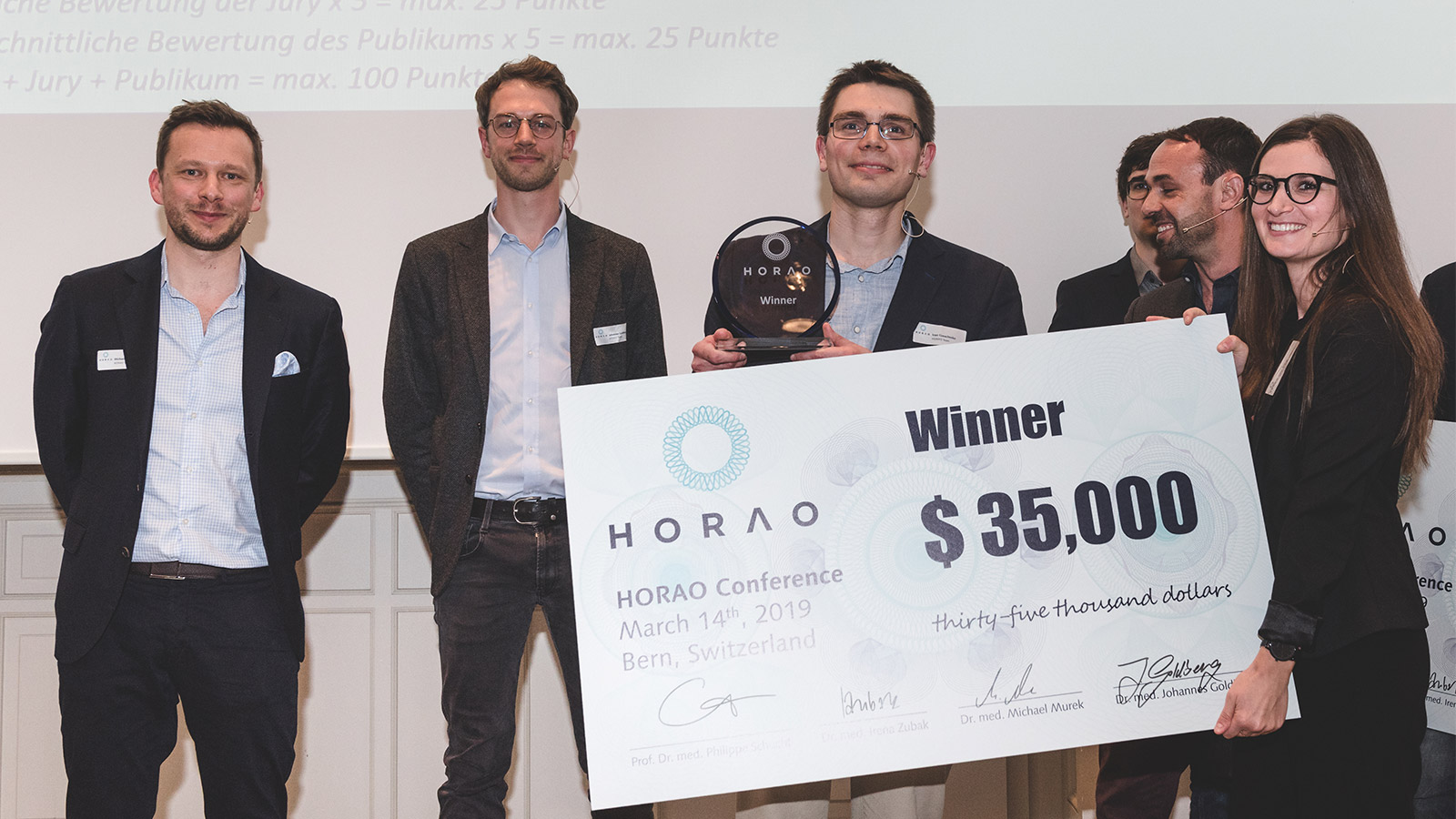At the HORAO conference on March 14, 2019, the jury and the audience chose the winning project. Ivan Gusachenko from France has won the global crowdsourcing competition and with it USD 35,000. His promising solution is now to be developed to market maturity so that brain tumors can be operated on even more safely in the future.
The five finalists from the United States, Canada, Spain, France and Germany delivered a neck-and-neck race at the public HORAO conference in Bern yesterday evening. They had all taken part in the global crowdsourcing competition (the intelligence of the masses) to develop an even more powerful microscope for brain tumor surgery in 2018 and had been nominated by an internationally renowned jury to participate in the final. At the HORAO conference, the five finalists faced the last challenge: they presented their proposed solution to the jury and the audience, who then used e-voting to select the ultimate winner.
Detecting brain tumors with Müller polarimetry
The winner, Ivan Gusachenko, a development engineer at Cailabs in Rennes in France, proposes using “Müller polarimetry optical imaging” to visualize tumors during brain tumor surgery. “Müller polarimetry” uses polarized (i.e., organized) light to examine tissue structures. Organized structures in the brain (brain fibers) reflect polarized light differently than unorganized cells (tumors). Gusachenko proposes equipping the surgical microscope with polarizers so that tumor margins can be directly superimposed onto the surgical microscope image viewed by the surgeon during the operation.
With the prize money of USD 35,000 and the ongoing support of an experienced coach, his project is now to be brought to market maturity.
Bernese pioneering spirit and innovation
The aim of the HORAO project is to find innovative technologies that can visualize the boundaries between tumor and surrounding healthy tissue (brain fibers) during brain tumor surgery so that neurosurgeons can operate on brain tumors even more safely.
The project is backed by a team led by Prof. Dr. med. Philippe Schucht, Senior Physician at the Department of Neurosurgery at Inselspital, Bern University Hospital. In 2017, the team successfully carried out the first crowdfunding campaign in the field of medical research in Switzerland, before launching a global crowdsourcing competition in 2018. Crowdsourcing is still relatively unknown in Switzerland, unlike crowdfunding, but it combines the creative and intellectual potential of thousands and thousands of innovators from a wide range of fields worldwide.
A total of more than 10,000 people showed an interest in HORAO crowdsourcing. More than 270 researchers and 18 teams from over 30 countries on all continents of the world took part in the competition. 45 projects from over 20 countries were submitted.
An overview of the five finalists
| Rank | Finalist | Solution proposal | Country | Prize money |
| 1 | Ivan Gusachenko | Detecting brain tumors with “Müller polarimetry” | France | $ 35 000 |
| 2 | Leon Weninger’s and Daniel Truhn’s team | Detecting brain tumors with polarized light | Germany | $ 12 000 |
| 3 | Brent Weyers's team | Detecting brain tumors using a fluorescence spectroscopy instrument (ms-TRFS) | USA | $ 1 000 |
| Finalist | Alicia Martinez-González | Detecting brain tumors using mathematical software | Spain | $ 1 000 |
| Finalist | Cliff Edwards | Detecting brain tumors using optical polarization imaging | Canada | $ 1 000 |
What does HORAO mean?
“Orao” is a verb of Greek origin. It has many inherent meanings that symbolize the complexity of the project: on the one hand, HORAO means to see something with your eyes; on the other hand, it also means to see something with your mind. Neurosurgeons need both.
Related News
- From research to the operating room – new imaging for neurosurgery12.12.23 - Another major milestone in HORAO research has been reached: a newly developed type of microscope is used during brain tumor surgery.
- Multi-million SNF grant for Prof. Philippe Schucht and his HORAO project23.12.21 - A great honor for Prof. Philippe Schucht, Deputy Head of the Neurosurgery Department, Head of Neuro-Oncology, and his team.
- HORAO receives 45 project submissions19.11.18 - The Department of Neurosurgery received 45 project submissions from 23 different countries for its award-winning HORAO project in the global…
- Successful crowdfunding19.09.17 - The Department of Neurosurgery at Inselspital, Bern University Hospital has done it: it has successfully completed the crowdfunding campaign for the…

